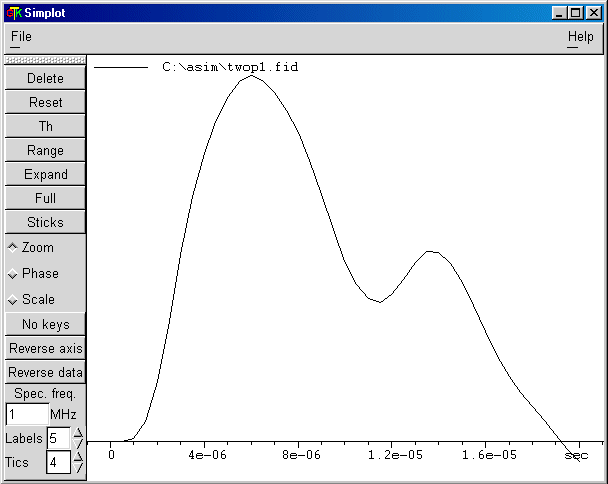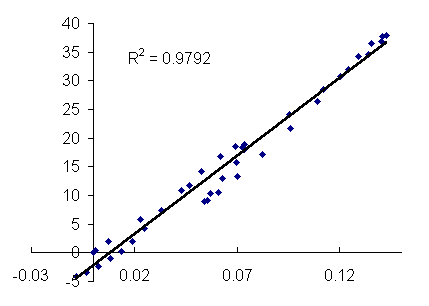We have simulated the same experiment as that described in Example 1 using SIMPSON version 1.1.0, a general simulation program for solid-state NMR spectroscopy provided by M. Bak, J. T. Rasmussen, and N. C. Nielsen, J. Magn. Reson. 147, 296-330 (2000).
*****Simpson 1 for two pulses*****
# twop1.in
# spin-3/2 central-line intensity optimization
# with p1 in two-pulse MAS sequence
spinsys {
channels 23Na
nuclei 23Na
quadrupole 1 1 1e6 0 0 0 0
}
par {
spin_rate 10000
variable tsw 0.5
sw 1.0e6/tsw
np 41
crystal_file rep320
gamma_angles 10
start_operator I1z
verbose 1101
variable rf 100000
proton_frequency 400e6
}
proc pulseq {} {
global par
maxdt $par(tsw)
matrix set 1 elements {{1 4} {4 1}}
matrix set detect elements {{2 3}}
acq
for {set i 1} {$i < $par(np)} {incr i} {
pulse $par(tsw) $par(rf) x
store 2
filter 1
pulse 1.5 $par(rf) x
acq -y
reset
prop 2
}
}
proc main {} {
global par
fsave [fsimpson] $par(name).fid
puts "Larmor frequency (Hz) of 23Na: "
puts [resfreq 23Na $par(proton_frequency)]
}
|
***Comment***
File name.
Description.
Spin I = 3/2.
1st-order
quadrupole
interaction,
qcc = 1 MHz,
eta = 0.
10 kHz.
0.5 µs increment.
1st pulse: 20 µs.
100 kHz RF pulse.
0.5 µs increment.
3Q and -3Q from
the 1st pulse,
density matrix
convention.
Central transition,
fictitious spin-1/2
convention.
No pulse,
no signal.
1st x-pulse is
variable pulse.
Save propagator
at the end of
1st x-pulse.
Select -3Q and 3Q
coherences.
The 2nd x-pulse
has 1.5 µs duration.
Receiver -y.
Reset propagator to
initial value.
Recall the propagator
at the end of the
1st x-pulse.
|
SIMPSON uses gyromagnetic ratios provided by IUPAC for the determination of the Larmor frequency of a nucleus. For example:
23Na Larmor frequency = Proton Larmor frequency * 23Na gyromagnetic ratio / Proton gyromagnetic ratio;
400 MHz * 7.0808493 / 26.7522128 = 105.8731007 MHz.
This curve represents the simulated central-line intensity versus the first-pulse length p1 with SIMPSON for a spin I = 3/2 system excited by the two-pulse MAS sequence.


This figure represents the correlation curve relating two simulations generated with SIMPSON (Simpson 1) and JDK1.3 Java applet (Example 1) for the two-pulse MAS sequence applied to a spin I = 3/2 system.
